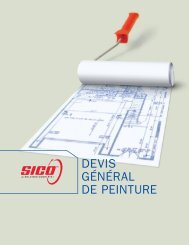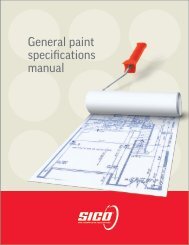GENERAL SPECIFICATIONS BINDER - Paint for professionals
GENERAL SPECIFICATIONS BINDER - Paint for professionals
GENERAL SPECIFICATIONS BINDER - Paint for professionals
Create successful ePaper yourself
Turn your PDF publications into a flip-book with our unique Google optimized e-Paper software.
e) COnCrete<br />
Concrete shall have cured <strong>for</strong> at least 28 days. Remove all mortar spatters, loose<br />
sand grains and dirt by raking or brushing. Fill holes, cracks, honeycombs and<br />
other surface defects with a cement mortar and let harden.<br />
If there are efflorescent salts, apply a muriatic acid <strong>for</strong>mula (POLYPREP 771-127)<br />
or a RUST-OLEUM phosphoric acid solution #108, letting it stand until bubbling<br />
stops on the concrete surface (15 to 20 minutes). Rinse thoroughly with clear<br />
water be<strong>for</strong>e surface dries. Repeat operation until concrete becomes rough. Let<br />
surface dry. Muriatic acid is of no use in removing oils and other greasy<br />
residues. Eliminate any trace of grease, tar or moulding oils by washing the<br />
surface with RUST-OLEUM cleaning agent #3599, rinse and let dry. Solvents<br />
should not be used to clean concrete since they dissolve contaminants and make<br />
them further penetrate the concrete.<br />
Highly polished concrete, tinted concrete, old concrete coated with a sealer<br />
or any other unsuitable topcoat will require Blast Track mechanical treatment<br />
be<strong>for</strong>e being recoated.<br />
The presence of humidity in the concrete can hinder product adhesion and<br />
hardness. It is necessary to test the level of humidity of the concrete surface<br />
be<strong>for</strong>e coating application. To test the level of humidity of a previously cleaned<br />
concrete surface:<br />
1. Let concrete dry <strong>for</strong> 24 hours after cleaning and be<strong>for</strong>e testing <strong>for</strong><br />
humidity.<br />
2. Be<strong>for</strong>e testing <strong>for</strong> humidity, ensure that the concrete temperature is above<br />
15°C (60°F). Low temperatures slow down the migration of the humidity and<br />
give false results.<br />
3. Test surface humidity in 4 or 5 places. An electrode moisture meter can be<br />
used (humidity level must not exceed 4% of mass) or fasten plastic film with<br />
masking tape to surfaces to be tested. Plastic film must remain in place <strong>for</strong><br />
24 hours if the temperature is above 20°C, 3 days if the temperature range<br />
is between 5 and 20°C. Testing cannot be done if the temperature is lower<br />
than 5°C. Once required time has elapsed, check <strong>for</strong> any trace of humidity<br />
(droplets under the plastic film).<br />
4. If no humidity is present, apply the product of your choice. If humidity is<br />
found, install false flooring that includes a moisture barrier.<br />
BrICKs, stOnes, BlOCKs AnD Other mAsOnrY<br />
Remove all mortar spatters and <strong>for</strong>eign matter. Use a broom or stiff brush to<br />
remove salts, dust and loose aggregates.<br />
When asbestos-cement is to be used <strong>for</strong> exteriors, coat both faces of the panels<br />
to prevent water absorption that can cause efflorescence.<br />
f) WAllBOArD (GYPsum BOArD)<br />
The surface must be clean, nails countersunk and holes filled. Sand joints lightly<br />
where rough or grainy, then dust clean.<br />
G) PlAster<br />
Make sure the finish coat of plaster has dried and hardened at a temperature<br />
not below 12°C (55°F), and that the room has been properly ventilated. Dry<br />
plaster should not contain more than 6% moisture, as measured with a moisture<br />
meter. Fill all cracks with patching plaster after widening them. Scrape away<br />
any grit and rough edges.<br />
h) metAls<br />
Iron and steel (small surfaces)<br />
Remove rust, mill scale, welding flux and other solid contaminants with a power<br />
wire brush or sandblast (if needed). Hand cleaning with a wire brush or with<br />
emery cloth is acceptable <strong>for</strong> small work. Treat the metal with CORROSTOP ULTRA<br />
metal conditioner and rust remover 635-104, rinse with clear water, and then<br />
wipe dry. Apply the anti-corrosion primer as soon as possible after cleaning the<br />
metal (as soon as the surface is dry: not more than 4 hours).<br />
p. 4<br />
Iron and steel (large surfaces)<br />
Steam blasting is recommended <strong>for</strong> the removal of grease, oil, salts, acids,<br />
alkalis and any similar chemical residue on large surfaces. To ensure maximum<br />
efficiency, steam blasting should be combined with an alkaline cleaning (using<br />
a concentrated solution of trisodium phosphate – TSP – POLYPREP 771-137).<br />
• Surface must be completely dry and free of any residue prior to application<br />
of coating.<br />
• A rust-inhibiting primer must be applied to the surface as soon as possible<br />
after cleaning and drying surfaces (maximum of 4 hours).<br />
Very rusty iron and steel (large surfaces)<br />
Sand blasting is the most efficient method <strong>for</strong> cleaning steel surfaces. This type<br />
of cleaning treatment is recommended in order to remove tartar, scaly rust and<br />
any other existing coating.<br />
Certain metals and alloys require a special surface preparation.<br />
Shop-primed steel and cast<br />
Wash all surfaces with POLYPREP thinner 875-104 to remove grease, oil, dirt<br />
and dust. If rust has appeared on areas where the primed steel and cast have<br />
been damaged, remove the rust with a wire brush, then touch up the bare metal<br />
with an alkyd primer <strong>for</strong> metal 922-260 or 525-727.<br />
Galvanized metal<br />
Clean with CORROSTOP ULTRA metal conditioner 635-104 to assure better<br />
adhesion of the paints after oily or greasy stains have been removed with<br />
POLYPREP 875-104. Then apply a coat of CORROSTOP ULTRA latex primer<br />
635-045. If rust is present, it should be removed with CORROSTOP ULTRA rust<br />
remover 635-104, and the affected areas covered with an alkyd primer <strong>for</strong> metal<br />
922-260 or 525-727.<br />
Note: Never use muriatic acid (hydrochloric), vinegar (acetic acid), copper<br />
sulphate or other preparations not suited <strong>for</strong> treating galvanized metal.<br />
Aluminum and light alloys<br />
Aluminum exposed to corrosive environments requires protection with paint. Clean<br />
the surface with CORROSTOP ULTRA 635-104. Use an alkyd primer <strong>for</strong> metal<br />
922-260 or 525-727 or CORROSTOP ULTRA latex primer <strong>for</strong> metal 635-045, but<br />
never use a primer that contains lead.<br />
Note: For galvalum, use latex primer 635-045.<br />
Copper, brass, bronze and stainless steel<br />
Clean with CORROSTOP ULTRA metal conditioner 635-104. No primer required:<br />
apply the finishing paint or varnish directly over the cleaned metal. Etch stainless<br />
steel lightly with sandpaper <strong>for</strong> metal.<br />
I) ACOustICAl tIles<br />
Seal stains with POLYPREP shellac 205-112 or POLYPREP stain killer or primer<br />
145-series. Spot prime with SICO EXPERT alkyd undercoater 880-114.<br />
J) Other mAterIAls<br />
Ceramic, melamine, Formica, stratified material, glass, plastics and PVC.<br />
Surface must be clean, dry, free of dust, dirt, grease, oil, wax and any other<br />
contaminant that could reduce the primer adhesion.<br />
Fibreglass<br />
A light cleaning with acetone is recommended in order to etch the surface.<br />
Ceramic, melamine, Formica and stratified material<br />
Sand surfaces with a grade 100 to 150 sanding paper be<strong>for</strong>e applying POLYPREP<br />
primer 145-033. This sanding will remove any sheen and create a surface profile<br />
favourable <strong>for</strong> maximum primer adhesion.





